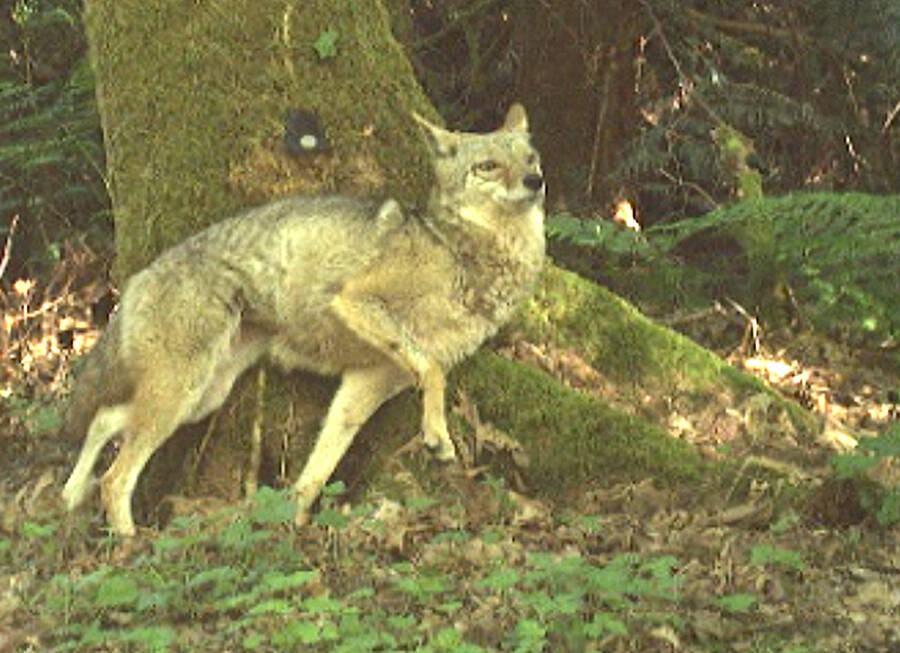While gardeners and horticulturalists travel to the Bloedel Reserve on Bainbridge Island there’s more to see than plants and trees—it’s also home to a diverse wildlife population.
Within the 140-acre park amphibians, pollinators, mammals and birds are busy croaking, buzzing, roaming and flying around the nature preserve while observers and cameras are documenting their presence.
In 2018, wildlife monitoring began in tandem with the Buxton Meadow and Bird Marsh Pollinator Landscape renovation project to better understand who makes their home in the gardens. In partnership with the Woodland Park Zoo and the Bainbridge Island Land Trust, staff and volunteers have discovered that rewilding efforts have created opportunities for many species to thrive.
Meadow manager Haley Wiggins, a plant ecologist, has been working to understand more about wildlife. By conducting surveys and using wildlife cameras, the team can “document the whole range of species around us,” Wiggins said. “Essentially, that whole project’s goal was really centered on improving wildlife habitat quality and increasing our pollinator habitat.”
One component involved moving the trail back from the pond edge to establish a thick vegetation barrier between wildlife and human visitors. Since then, the team has focused on bird count data collected by surveyors who spend about five minutes at a specific location where they listen, look and record anything they see or hear.
Birds
“We have an insane bird list. There are over 110 species that have been detected in the project area that I manage,” including a great horned owl and many cedar waxwings, said Wiggins, who eventually hopes to show that habitat improvement work leads directly to increased populations and diversity of birds and other wildlife.
The work takes many volunteers to observe and document, and Wiggins is looking to partner with other agencies or interested community members with any wildlife monitoring background. Wiggins mentioned how a visit from Gina King and Brenda Padgham from the land trust led to changes at the pond.
“What they noticed was we really didn’t have enough emergent aquatic vegetation, and our pond was too deep to grow many plants. So, they recommended coming up with ways to get more vegetation on the surface of the water.” The team added floating wetlands with native wetland plants on them, and they became an attraction where Canada geese nested in one of the duck boxes this spring.
That led to an interest in planting species of sedge and grass as egg-laying habitats for the native amphibians. So they started doing surveys around the ponds looking for egg masses in conjunction with the Woodland Park Zoo’s amphibian monitoring protocol.
The main amphibian species in the reserve include: northwestern and long-toed salamanders, the rough-skinned newt, and the Pacific chorus and northern red-legged frogs. They also look for the endangered Oregon spotted frog and the invasive American bullfrog, which is “a very problematic large frog. It’ll eat anything, and it’s detrimental to other amphibian populations,” Wiggins said.
Volunteers go out every month to survey egg masses and tadpoles in winter and spring, and then juveniles and adults later in summer.
Pollinators
In the meadow, one volunteer, a master beekeeper, regularly monitors four areas to record the pollinators and the kinds of flowers the bees, butterflies, moths and beetles are using, and Wiggins will try to establish more of those plants.
Wiggins said pollinators seem to like cow parsnip, which can reach up to 6 feet tall with large umbrella-like clusters of flowers.
During the summers of 2021 and 2022, the meadow hosted mason and leafcutter bees to encourage them to colonize and nest in the habitat, along with the property’s bumblebees, sweat bees and honeybees.
Mammals
Many animals are moving through the park, and two cameras now record their actions. One camera is in the marsh, keeping an eye on wood duck nesting boxes. The other camera is in a wooded area, pointed at a tree with a smelly scent disk attracting carnivores.
“We’ve seen lots of carnivores that are really curious about this little scented disc on a tree,” Wiggins said. The camera has photographed a deer, raccoons, a river otter and coyotes. The otters are regular visitors this time of year because they prey on ducklings and goslings.
In the marsh, the camera has captured images of a great blue heron, ducks, mergansers, geese, squirrels, osprey, eagles and a bunny. “This one bunny is just the star of the show and is on the camera every night. hopping through the air. It’s so sweet,” Wiggins said.
One mammal the reserve is carefully monitoring is bats, which are very important to the ecosystem. The state Department of Fish and Wildlife recently reported that white-nose syndrome, which has killed millions of bats across North America, had been detected in nearby Jefferson County this year.
In cooperation with Bats Northwest, the bats are monitored with acoustic equipment to collect distinct audio signatures to detect species that were flying around that night. Wiggins said, “They said that they had far more detections in our bird marsh than any of the other places that they monitor.”
Wiggins said Bloedel can always use more volunteers. For people who want to help the environment but only have a little time, weekly monitoring is a small time commitment. “This isn’t something we can devote as much time to, and we need to start telling the stories of these animals that are using our grounds.”



